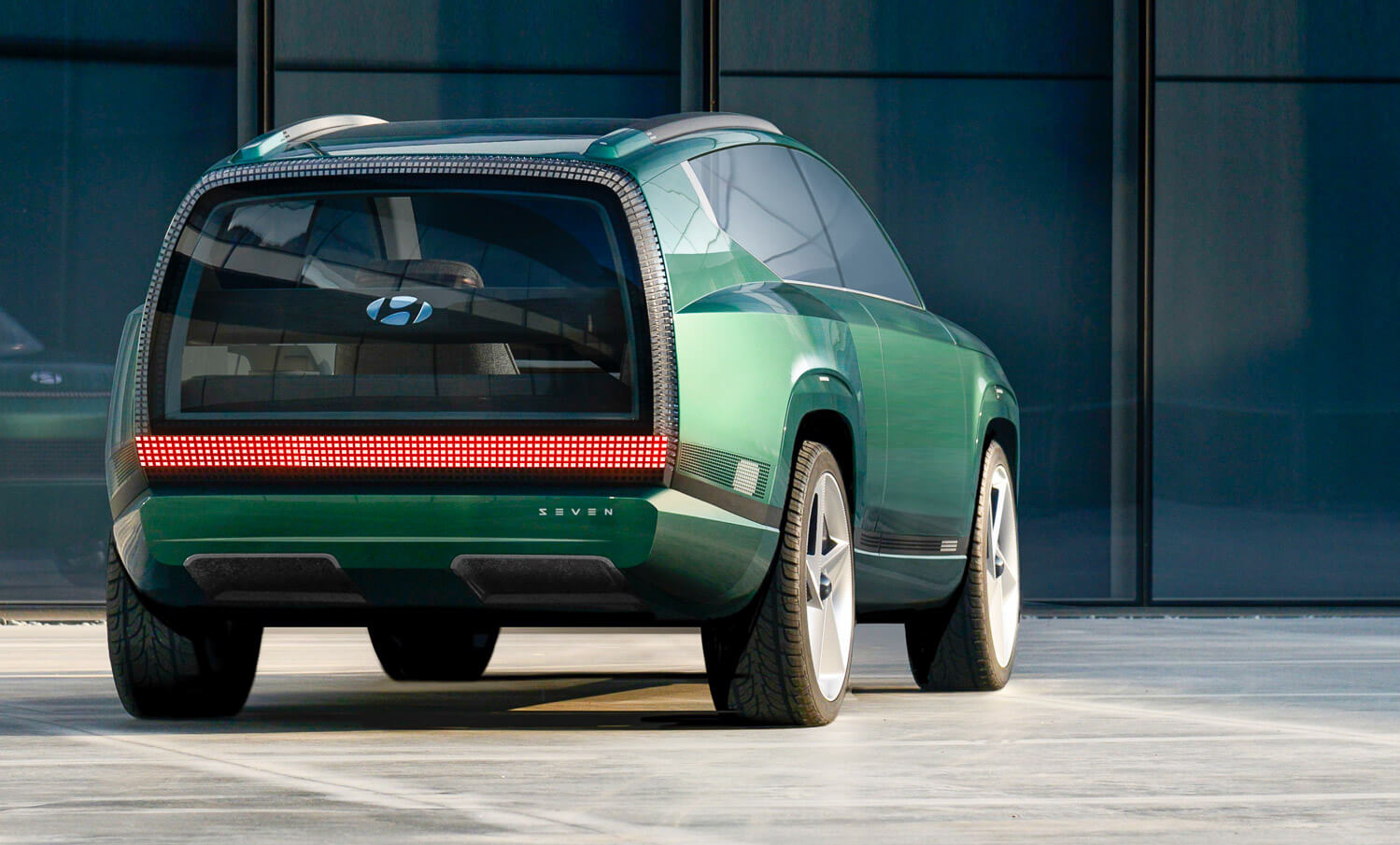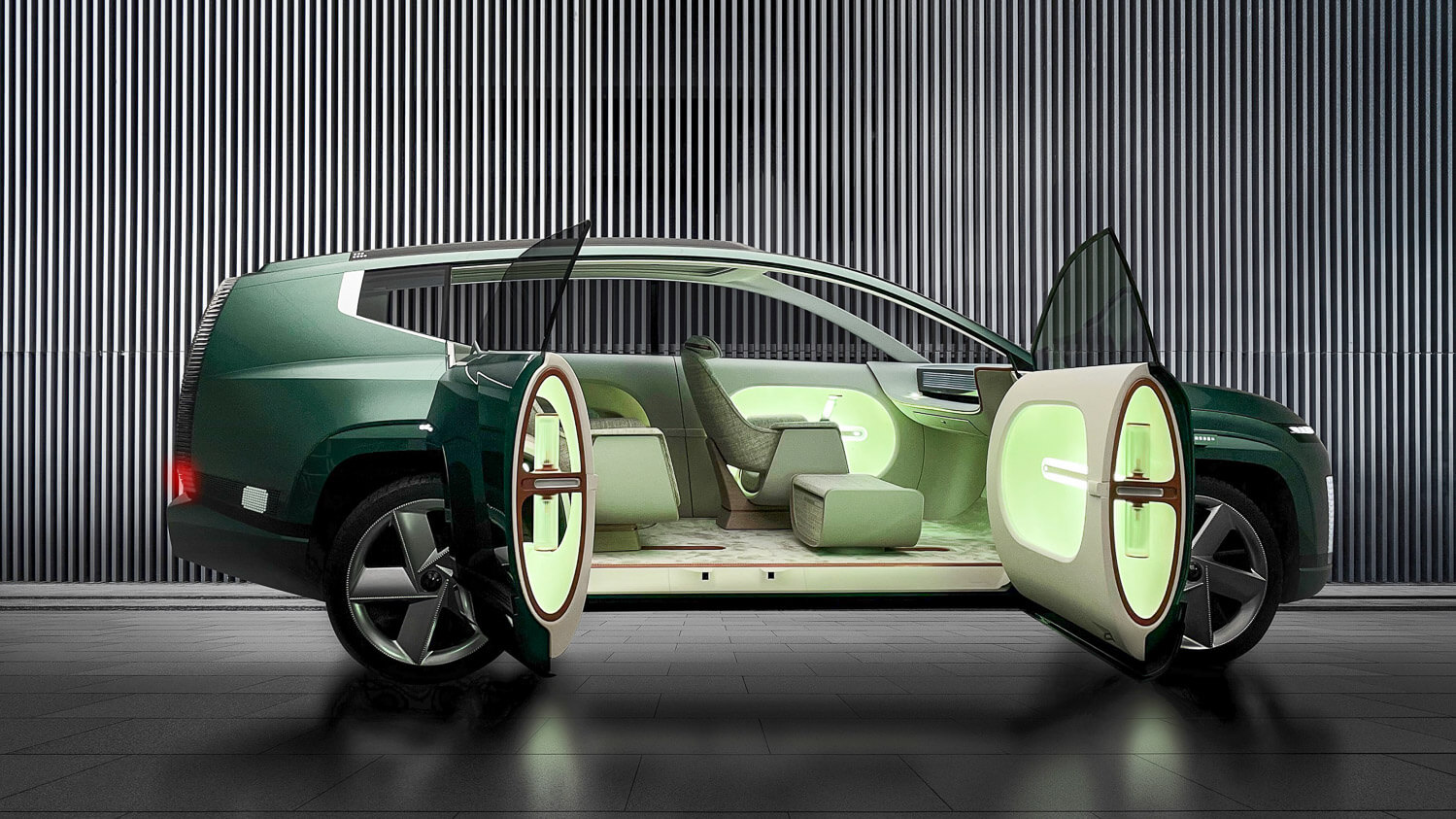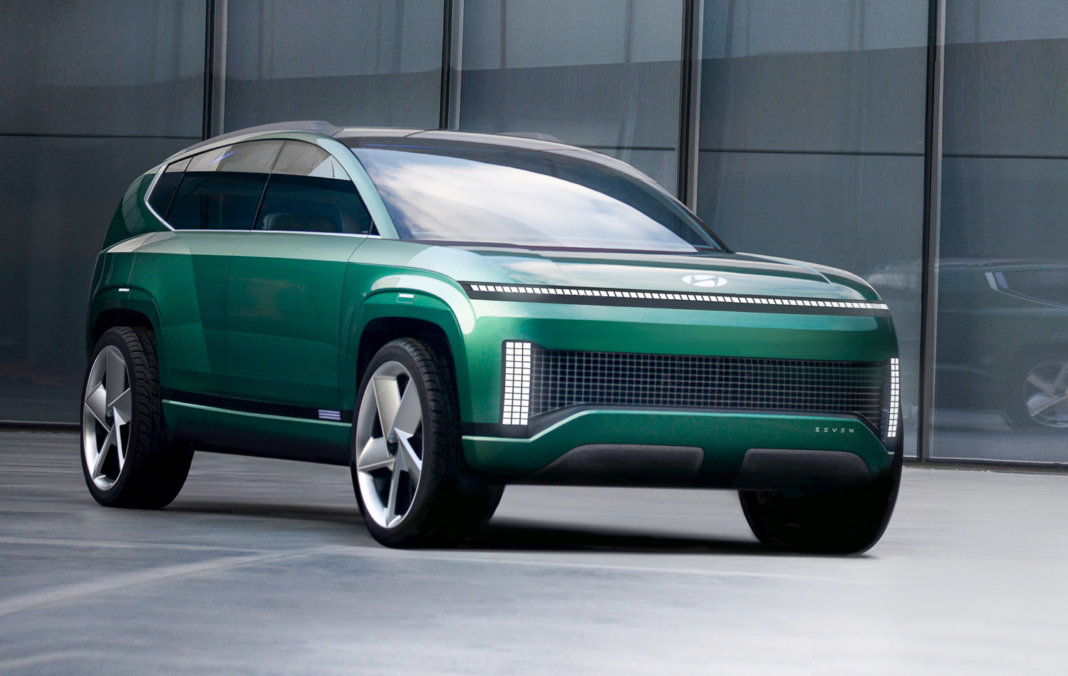We know it’s a concept vehicle, but questions still remain unanswered, like “where are the seat belts?. Regardless, Hyundai Motor Company has revealed SEVEN, a new sport utility electric vehicle (SUEV) concept at AutoMobility LA. This electric SUV concept will be on display in Hyundai Motor’s booth, along with other segment-leading products such as IONIQ 5, and XCIENT Fuel Cell, at the LA Convention Centre, Nov. 19-28.
Following the 45 concept in 2019 and the Prophecy concept in 2020, the SEVEN concept opens a new chapter for the IONIQ brand, Hyundai’s dedicated battery electric vehicle (BEV) showcase. SEVEN is a clear representation of Hyundai’s commitment to carbon neutrality by 2045.
“The SEVEN concept demonstrates Hyundai’s creative vision and advanced technological development for our electrified mobility future,” said José Muñoz, President and CEO, Hyundai Motor North America. “Its innovative interior space, eco-friendly powertrain and cutting-edge safety and convenience technologies reveal an exciting future for Hyundai SUV customers.”
The SEVEN debut press conference can be viewed at Hyundai Motor America website. Hyundai Motor also released a lifestyle-oriented storytelling video, featuring SEVEN’s customer experience concept and its various in-car appliances. The film can be viewed at HyundaiWorldwide YouTube channel.
IONIQ: Dedicated BEV brand embodying Hyundai’s future mobility vision
Hyundai says that every vehicle developed for the IONIQ brand offers a next generation customer experience that seamlessly integrates the most advanced technologies into everyday life settings. SEVEN concept is the perfect example of IONIQ, with its space innovation and hygienic features transforming the vehicle as an innovative living space on wheels.
“As a tangible proof of Hyundai’s vision of ‘Progress for Humanity’, IONIQ changes the paradigm of electric vehicle customer experiences, accommodating diverse lifestyles without constraints,” said Thomas Schemera, Executive Vice President and Global Chief Marketing Officer, Hyundai Motor Company. “SEVEN represents our commitment to a human-centered approach to redefine everyday experiences.”
Redefining SUV with aerodynamically pure exterior and powerful presence
SEVEN concept is built upon Hyundai Motor Group’s Electric-Global Modular Platform (E-GMP), a dedicated BEV architecture. E-GMP’s long wheelbase and flat platform floor.
SEVEN has an aerodynamically pure silhouette instinctively divergent from a typical SUV. The low, leading edge of the hood, a single, streamlined roofline and elongated wheelbase communicate a clear break from traditional SUVs powered by internal combustion engines, says Hyundai. In support of SEVEN’s road presence are wheels that feature integrated Active Air Flaps, which deploy or retract depending on brake-cooling or low-drag requirements.
Even under darkness of night, SEVEN is easily identified by IONIQ’s signature Parametric Pixel lights that deliver a Welcome Light Sequence on start-up. Parametric Pixels provide a common design thread, linking digital and analog styles, a reminder that its designers considered every aspect of SEVEN’s design, down to a single pixel.

A welcoming, premium lounge style interior for the autonomous driving era
SEVEN’s wheelbase reaches 3.2 metres, thanks to its design cue to push the wheels outward to extend the wheelbase as much as possible. The flat floor allows Hyundai Motor to explore an alternative to the traditional row-based seat arrangements, creating a more fluid interior layout. The Pillarless Coach Doors offer an entrance to reveal a welcoming interior with a completely new dimension of space. The streamlined roofline, long wheelbase and flat floor that extends to the third row opens new opportunities to furnish the interior like a premium lounge.
Hyundai says that the SEVEN also embodies Hyundai’s future vision of autonomous mobility. The driver’s seat features a retractable control stick that hides away when not in use. Without the need for the usual driver’s equipment, the ultra slim cockpit and integrated screens create a lounge-like experience. The seat arrangement is unlike traditional SUVs, with swiveling lounge chairs and a curved bench seat. This seat arrangement can be customised depending on driver-controlled or autonomous driving modes.

SEVEN has a Universal Island console, specially designed home appliances and a multi-functional Smart Hub graphic user interface. When the Smart Hub and front seatscombine with the rear chaise-lounge seating, SEVEN becomes an environment where customers can experience quality time alone or together in the glow of side-door ambient light. In transit, SEVEN’s built-in mini fridge provides chilled refreshment on the go and shoe-care compartments refresh passengers’ footwear.
The concept’s vision roof features a panoramic screen that not only displays various content based on passengers’ tastes, but also changes the overall interior atmosphere to guarantee maximum relaxation and pleasure during the journey.
“SEVEN dares to break from the beaten path,” said SangYup Lee, Senior Vice President, Head of Hyundai Global Design. “SEVEN paves the way forward for what an SUV needs to become in the EV era with a unique aerodynamic pure form that does not compromise on its rugged personality. The interior opens up a new dimension of space that cares for its passenger as a family living space.”
A sustainable and hygienic mobility environment
Hyundai Motor has focused on developing vehicles to always ensure a safe and healthy travel experience. SEVEN uses various eco-friendly materials while offering segment-leading hygienic features, such as Hygiene Airflow System and UVC Sterilisation.
Hyundai applied bio-paint to SEVEN’s exterior and hygienically-recycled and renewable materials throughout the interior. Mineral plaster, bamboo wood and carpet, bio resin and interior paint are based on renewable sources that can reduce pollution from the production process. Extensive use of copper and hygienically treated fabric with proven antibacterial functions ensure all surfaces inside SEVEN remain clean at all times.
The Hygiene Airflow System takes inspiration from the sophisticated airflow management of passenger aircrafts. In its vertical mode, air is taken in through built in air intakes in the roof rails from which the air travels from above to below, and extracted through the exterior vent behind the rear wheels. In its horizontal mode, the air flows from the slim dashboard to the rear vents.
Most importantly, this system can activate independently whether the vehicle is in motion or not to reduce cross-contamination among passengers and isolates the airflow between front and rear occupants.
UVC Sterilisation activates once the vehicle is vacated of its passengers. The control stick, first-row storage drawerand speakers pop up. Then, integrated sanitising UVC lights help clean the living space of bacteria and viruses. In addition, there are sanitising storage compartments in the bench and Smart Hub console for personal belongings.
Powerful Performance with an all-electric range target of over 300 miles
SEVEN should be able to provide outstanding driving range and ultra-fast charging capabilities, delivering a driving experience tailored to customer’s needs. In a real-world situation with a 350-kW charger, SEVEN is capable of charging from 10 percent to 80 percent in about 20 minutes. The concept is also engineered to achieve a target range of over 500Km.
* Note: SEVEN is a concept vehicle, and its specifications should not be considered as those of an upcoming production model.













































